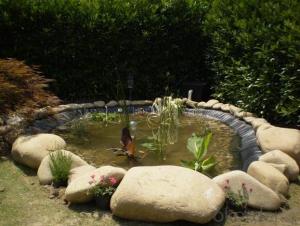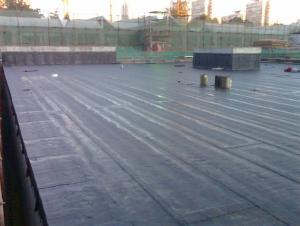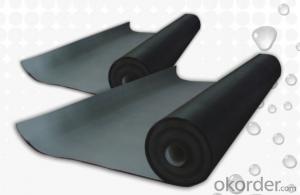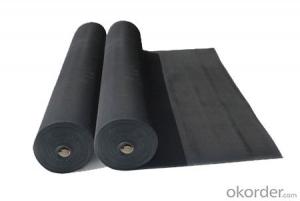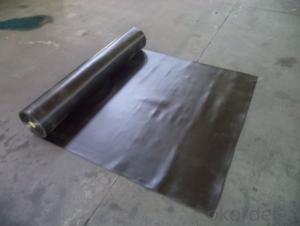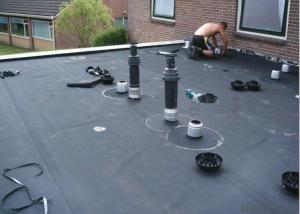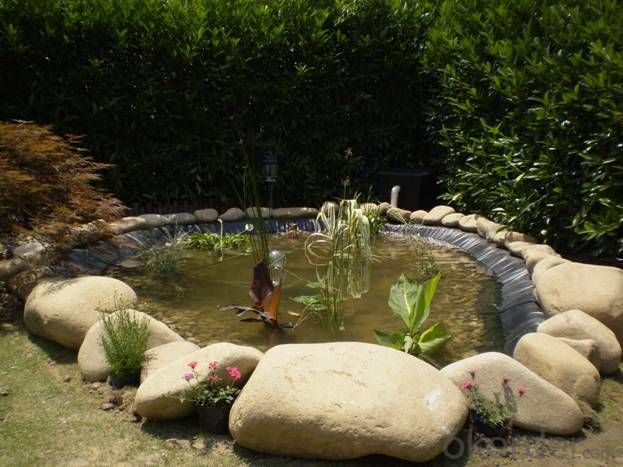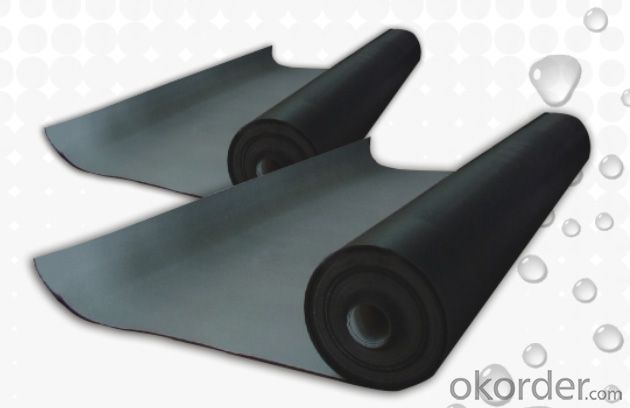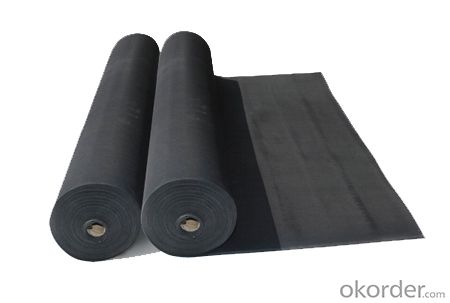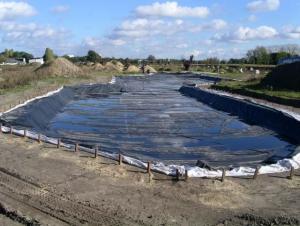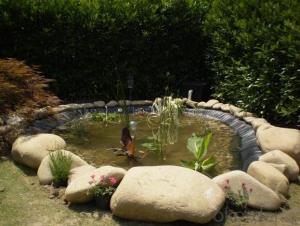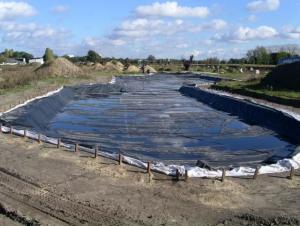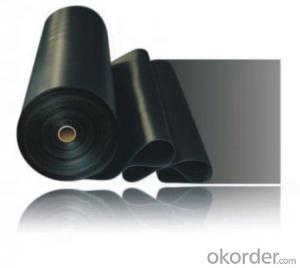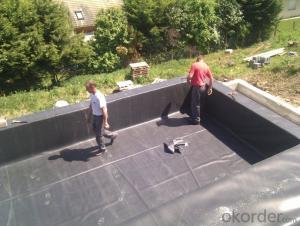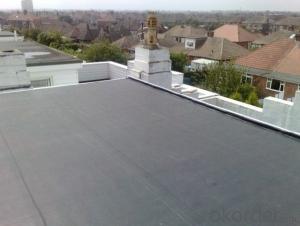EPDM Waterproofing Membrane for Manmade Pond
- Loading Port:
- Shanghai
- Payment Terms:
- TT OR LC
- Min Order Qty:
- 50000 m²
- Supply Capability:
- 5000000 m²/month
OKorder Service Pledge
OKorder Financial Service
You Might Also Like
EPDM Waterproofing Membrane for Manmade Pond
Description Of EPDM Waterproofing Membrane for Manmade Pond:
·Filament polyester filler base sheet material:
·The combination of filament polyester filler base and SBS modified bitumen forms an excellent comprehensive performance and high quality waterproof sheet material;
·High strength waterproof layer and strong water pressure resistance;
·Good performance of breaking resistance, tearing resistance, fatigue resistance, corrosion resistance, mould resistance and weather resistance;
·High tensile strength, high elongation, high adaptive capacity to base shrinkage deformation and fracture;
·Good resistance performance of low and high temperature: It could still work under -20℃ , be applicable to cold and hot regions, especially in chilly region;
·Good workability: It can be constructed by heat fusion method in the four seasons of the whole year and hot-joint is reliable and durable.
·Alkali-free glass fiber filler base sheet material:
·Combination of economical filler base and high performance SBS modified bitumen.
·Higher tensile strength, excellent resistance to high and low temperature.
·Good performance of corrosion resistance, mould resistance, weather resistance and good workability.
·Glass fiber reinforced polyester filler base sheet material:
·It is safe and eco-friendly by using mechanical mounting of construction.
·The product has better dimensional stabiliy.
Main Features of EPDM Waterproofing Membrane for Manmade Pond:
EPDM rubber waterproof membrane can operate in single layer, and is characterized by light weight, ageing resistance, with long service life, great tensile strength and high extension coefficient, which has strong adaptability to shrinkage, cracking and deformation in basic level. It can work well within -40°C to 100 °C and can be constructed with a single layer in ambient temperature. The service life of EPDM rubber waterproof membrane is up to 50 years, which is known as "King of Waterproof".
Specifications of EPDM Waterproofing Membrane for Manmade Pond:
Type | EPDM Rubber Waterproof Membrane | ||
Type | Vulcanized and Weldable | ||
Thickness | 1.2mm | 1.5mm | 2.0mm |
Weight(kg/m2) | 1.54-1.58 | 1.79-1.83 | 2.25-2.29 |
Size | 1.2m (width) * 20m (length)/roll. Weldable type could be 4m wide. | ||
Packing | 24㎡/roll, with plastic bag. (Weldable: 80㎡/roll) | ||
Usage | Roof, basement, pond, Lake, steel structure roofing, underground, tunnel, etc | ||
NO. | Item | Unit | Technical requirement | |
1 | Tolerance on size | Thickness | % | ±10 |
Width | % | ±1 | ||
length | % | Does not allow negative | ||
2 | Fracture tensile strength (normal temperature ) | Mpa | ≥7.5 | |
Fracture tensile strength(60 ℃) | Mpa | ≥2.3 | ||
3 | Breaking elongation,(normal temperature ) | % | ≥450 | |
Breaking elongation,(-20 ℃) | % | ≥200 | ||
4 | Tearing resistance | KN/m | ≥25 | |
5 | Impermeability | * | 0.3Mpa impermeable | |
6 | Bending at low temperature | °C | ≤-40 | |
7 | Elongation and contraction volume at heating | Elongation | mm | ≤2 |
contraction | mm | ≤4 | ||
8 | Hot air aging 80°CX168h | Fracture strength retention | % | ≥80 |
Rate of elongation at break | % | ≥70 | ||
9 | Alkaline (saturated Ca(OH)2 solution normal Temperature x2 168h ) | Fracture strength retention | % | ≥80 |
Rate of elongation at break | % | ≥80 | ||
10 | Ozone aging (40 degree by 168 hours ) | Elongation 40% , 500x10-2 | * | No Crack |
11 | Phytotron aging | Fracture strength retention | % | ≥80 |
Rate of elongation at break | % | ≥70 | ||
Applications of EPDM Waterproofing Membrane for Manmade Pond:
Widely used in roofs, basement, toilet ,swimming pool, and all kinds of industry and civil building waterproofing, reservoir, vivicism, bridge, underground, tunnel and dam waterproofing ,especially to the keystone waterproofing projects which is durability, high corrosion resistance and easy deformation.
Construction Site of EPDM Waterproofing Membrane for Manmade Pond:
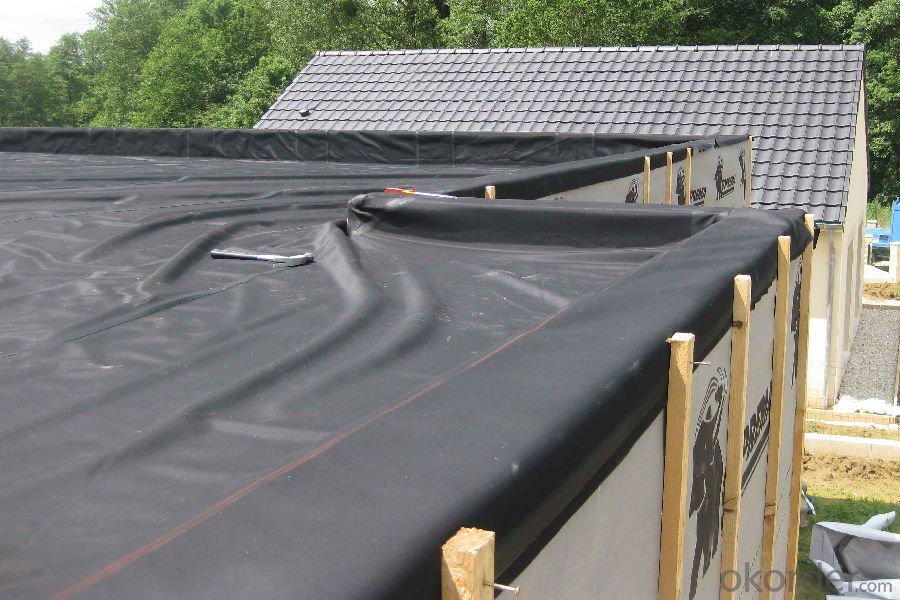
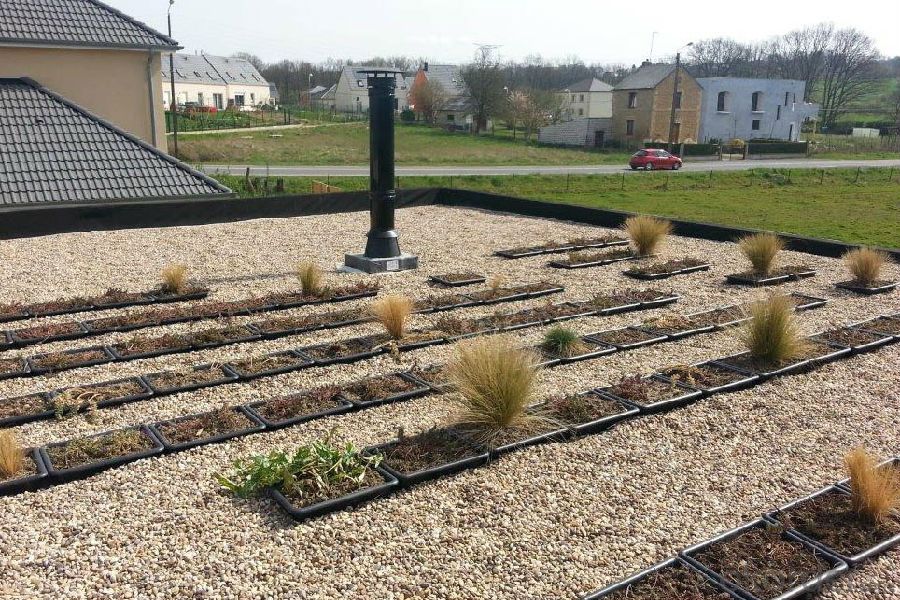
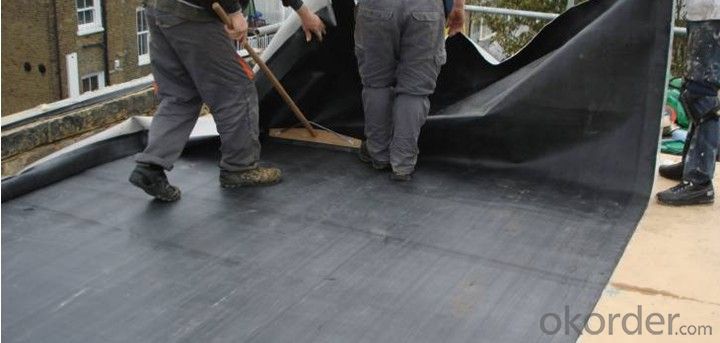
IMages of EPDM Waterproofing Membrane for Manmade Pond:
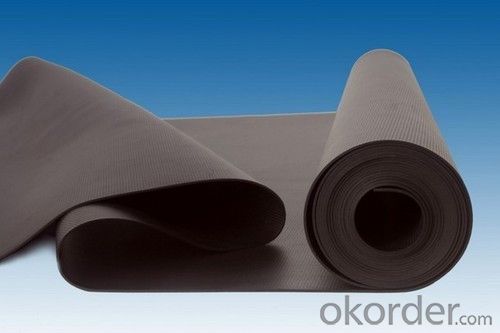
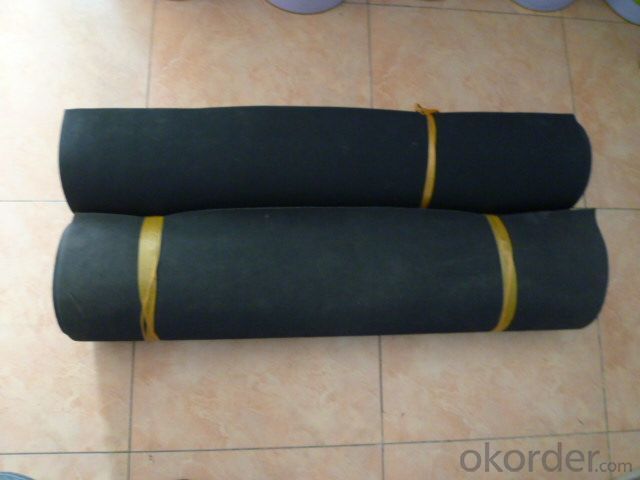
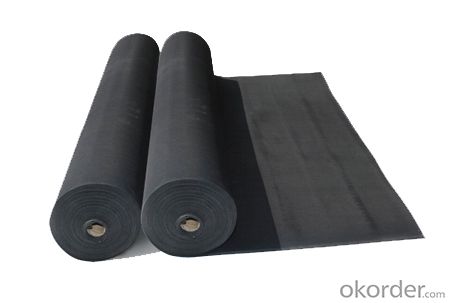
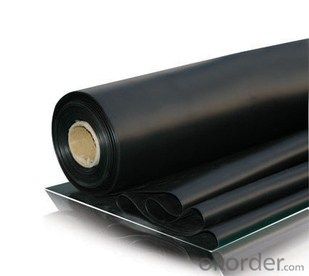
FAQ of EPDM Waterproofing Membrane for Manmade Pond:
1. What are we supplying?
We are specialized in producing Colorful Asphalt Roof Shingle, SBS/APP modified bitumen waterproof membrane, Self adhesive bitumen waterproof membrane, PVC waterproofing membrane, EPDM rubber roofing membrane, Single Component Polyurethane Waterproof Coating, and Spray Polyurea Waterproof Coating
.
2. How Many years experience do we have?
We have been exported to more than 20 countries in the past 15 years.
3. How long do we usually reply your request?
We always reply our customer within 24 hours.
- Q: Can a waterproofing membrane be used for underground storage facilities?
- Yes, a waterproofing membrane can be used for underground storage facilities. Waterproofing membranes are designed to prevent water infiltration, making them an ideal solution for underground structures such as storage facilities. These membranes are typically made from materials such as bitumen, rubber, or polyethylene, which are highly resistant to water penetration. By installing a waterproofing membrane on the walls and floor of an underground storage facility, it helps to create a barrier that prevents water from seeping in, protecting the stored goods from moisture damage. Additionally, waterproofing membranes also help to prevent the growth of mold and mildew, which can be detrimental to the integrity of the structure and the items stored within. Overall, using a waterproofing membrane is a reliable and effective way to ensure the durability and longevity of an underground storage facility.
- Q: Waterproof building materials after the construction of drums, bubble is what reason?
- Reason 2: Construction, due to the construction of the membrane waterproof layer of paving is not true, so that part of the empty, remain in which to form a bubble. Control measures: in the asphalt waterproofing membrane construction, the first surface of the coil clean. When laying the web, the mastic should be painted evenly and carefully compaction work to enhance the cohesive force between the web and the base, the web and the web. High polymer modified asphalt waterproofing membrane construction, the flame heating to be uniform, full, moderate. Paving to roll forward while hot, while rolling with a pressure roller to exclude the air below the coil.
- Q: Can a waterproofing membrane be used in conjunction with paint or coatings?
- Yes, a waterproofing membrane can be used in conjunction with paint or coatings. In fact, combining a waterproofing membrane with paint or coatings is a common practice in many construction and renovation projects. The waterproofing membrane provides a barrier against moisture and prevents water infiltration, while the paint or coatings add aesthetic appeal and can provide additional protection against UV rays, weathering, and chemical exposure. By using both in conjunction, you can achieve a dual-layer protection system that ensures long-lasting durability and water resistance. However, it is essential to ensure compatibility between the waterproofing membrane and the paint or coatings to avoid any adverse reactions or loss of effectiveness. Consult with a professional or manufacturer guidelines to determine the best combination and application process for your specific project.
- Q: Does a waterproofing membrane require any specific cleaning methods?
- Yes, a waterproofing membrane typically requires specific cleaning methods. It is important to avoid using abrasive cleaners or tools that may damage the membrane. Instead, gentle cleaning solutions and soft brushes or cloths should be used to remove dirt and debris without compromising the membrane's integrity. Regular maintenance and cleaning will help prolong the lifespan and effectiveness of the waterproofing membrane.
- Q: Does a waterproofing membrane prevent mold and mildew growth?
- Indeed, the growth of mold and mildew can be prevented with the aid of a waterproofing membrane. These fungi flourish in environments characterized by dampness and moisture, but a waterproofing membrane acts as a barrier, thwarting the infiltration of water into the treated surfaces. By keeping moisture at bay, it diminishes the circumstances that facilitate the proliferation of mold and mildew. Nonetheless, it is crucial to acknowledge that while a waterproofing membrane is effective in preventing such growth, it does not ensure absolute protection. Adequate ventilation and consistent upkeep are also imperative in the battle against mold and mildew.
- Q: Can a waterproofing membrane be used for theme parks or amusement centers?
- Yes, a waterproofing membrane can be used for theme parks or amusement centers. These types of facilities often have water features, pools, or water rides that require effective waterproofing to prevent leaks or water damage. Waterproofing membranes provide a reliable and durable solution to keep these areas watertight, ensuring the safety and longevity of the park or center.
- Q: Is a waterproofing membrane resistant to punctures or tears?
- A waterproofing membrane is created to resist punctures or tears, being made from robust materials like PVC, TPO, or EPDM, renowned for their strength and damage resistance. These membranes undergo extensive testing to ensure they can endure different environmental conditions and potential causes of punctures or tears, like sharp objects or heavy foot traffic. Some waterproofing membranes even have reinforcement layers or added protection to further strengthen their resistance to punctures and tears. Nevertheless, it is crucial to note that while waterproofing membranes are highly durable, they are not entirely immune to damage. Proper installation, regular maintenance, and avoiding unnecessary stress or impact on the membrane can help extend its lifespan and enhance its performance.
- Q: Does a waterproofing membrane require a protective layer?
- Yes, a waterproofing membrane typically requires a protective layer. The protective layer serves multiple purposes. Firstly, it helps to prevent damage to the waterproofing membrane during and after installation. It acts as a barrier against sharp objects, construction debris, and potential punctures. Additionally, the protective layer helps to distribute loads evenly and provide stability to the membrane, reducing the risk of damage caused by foot traffic or heavy equipment. Furthermore, the protective layer serves as a UV barrier, shielding the waterproofing membrane from the harmful effects of sunlight exposure. UV rays can degrade the membrane over time, leading to reduced effectiveness and potential leaks. The protective layer also helps to regulate temperature fluctuations, which can expand and contract the membrane, causing stress and compromising its waterproofing capabilities. In summary, a protective layer is essential for the longevity and performance of a waterproofing membrane. It safeguards against physical damage, UV radiation, and temperature fluctuations, ensuring the membrane's effectiveness in keeping water out and preserving the integrity of the structure it protects.
- Q: Can a waterproofing membrane be used for railways or train stations?
- Yes, a waterproofing membrane can definitely be used for railways or train stations. Waterproofing membranes are commonly used in various construction projects to protect structures from water damage and ensure their longevity. In the case of railways and train stations, where there is constant exposure to weather elements and potential water infiltration, a waterproofing membrane can play a crucial role in preventing water ingress into the infrastructure. Waterproofing membranes are typically applied to different areas of the railway or train station, such as the underground tunnels, platforms, parking areas, and even the roofs. These membranes are designed to create a barrier against water and moisture, preventing them from seeping into the structure and causing damage. By preventing water infiltration, a waterproofing membrane helps to maintain the structural integrity of the railway or train station and extend its lifespan. In addition to protecting against water, waterproofing membranes also provide other benefits such as preventing the growth of mold and mildew, improving energy efficiency by reducing heat loss, and enhancing the overall durability of the structure. They are available in various types, including liquid-applied membranes, sheet membranes, and cementitious coatings, allowing for versatile application depending on the specific needs and requirements of the railway or train station project. Overall, the use of a waterproofing membrane in railways and train stations is highly recommended to ensure the long-term performance and maintenance of these critical infrastructures.
- Q: Can a waterproofing membrane be used in cold climates?
- Indeed, a waterproofing membrane is suitable for use in cold climates. It is highly advisable to utilize a waterproofing membrane in cold climates to safeguard structures from moisture damage caused by snow, ice, and freezing temperatures. These membranes are engineered to possess flexibility and durability, enabling them to endure extreme temperature fluctuations without experiencing cracks or deterioration. They establish a barrier that thwarts water from permeating the structure, a critical factor in cold climates where water can freeze and expand, resulting in substantial harm to buildings and infrastructure. Additionally, certain waterproofing membranes are specifically formulated to excel in cold weather conditions, offering heightened resistance to freeze-thaw cycles and ensuring long-term protection against water infiltration. Therefore, it is imperative to employ a high-quality waterproofing membrane in cold climates to uphold the integrity and longevity of structures.
Send your message to us
EPDM Waterproofing Membrane for Manmade Pond
- Loading Port:
- Shanghai
- Payment Terms:
- TT OR LC
- Min Order Qty:
- 50000 m²
- Supply Capability:
- 5000000 m²/month
OKorder Service Pledge
OKorder Financial Service
Similar products
Hot products
Hot Searches
Related keywords
